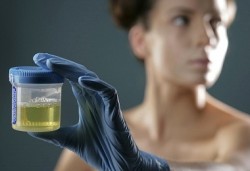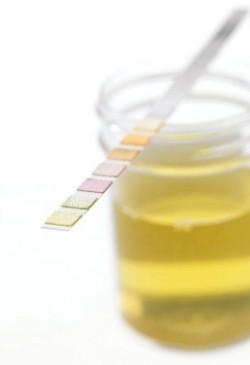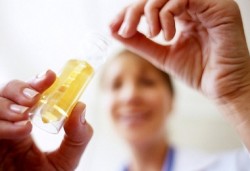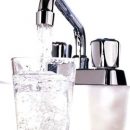Our site draws your attention that before collecting urine does not need to limit yourself in food, but it is worth paying attention to the number of sweets consumed, products of bright color, moderately drinking dining and therapeutic mineral water, not to overload yourself, doing sports. During menstruation, urine can not be handed.
For general analysis, you need the whole portion of the morning urine after a careful toilet of genital organs was conducted. The urine is filled with a clean container, on which there should be no traces from detergents and disinfectants. It is convenient to use a special disposable container that can be purchased at the pharmacy.
In order to avoid entering the sample elements of inflammation in the urethra and outdoor genital organs, you first need to release a slight amount of urine and only then collect it in the container the required portion. For a study, as a rule, about 100 ml of urine.
The laboratories are estimated by the general properties of urine, its physico-chemical indicators and the morphological composition of the sediment.
General characteristics of urine

The color, transparency and smell of urine defines its general characteristics.
Colour urine healthy person usually straw yellow. It can be a reddish shade due to the presence of hemoglobin or brown, due to bile pigments. For clarification, the sample is usually shaken - yellow foam accurately indicates that biliary pigments are contained in the urine. The milky white shade indicates the presence of fat elements, pus or inorganic phosphorus in the urine. Polyuria makes urine very light and weakly painted.
Smell does not matter when diagnosing. Fresh urine is usually odorless. The "apple" smell signals that in the urine of a sick diabetes of man appeared ketone bodies.
Transparency. Watering a healthy person is transparent, because all substances are in a dissolved state. If urine at the time of allocation is already muddy, it indicates the main number of cellular elements, salts, fat and bacteria.
Physico-chemical indicators of urine

For patients with diabetes mellitus, a special degree of proteinuria was allocated - microalbuminuria (conclusions are made by the number of microalbumin in the urine). Therefore, 0.0002 g / l and 0.0003 g / l and 0.0003 g / l and 0.0003 g / l and 0.0003 g / day are considered to be the highest rate of the norm of protein concentration in the urine.
Glucose in the urine. Conventional methods for the study of glucose in the urine in healthy people are not detected. Can be detected under the influence of certain medicines, in stress and consumption of excessive carbohydrates with food. In these cases, the amount of glucose in the urine exceeds the "renal threshold" - 9.99 mmol / l.
Glucosuria (the appearance of glucose in the urine) indicates disorders of a number of endocrine bodies. These may be diseases of the pancreas or thyroid glands, such as diabetes mellitus or Basedov disease, respectively.
Ketone bodies. Most often, ketone bodies are found in the urine of patients with severe form Sugar diabetes, Sometimes during brain injury, hemorrhage in the brain, as well as with a diet that contains a minor amount of carbohydrates. The result of the presence of ketone bodies in the urine is expressed by a semi-quantitative method: a weakly plating reaction (+), a positive reaction (++) and (+++), sharply positive (++++).
Pigments content in urine.
Bilirubin Healthy people in the urine does not find it, its presence can be determined in the case of mechanical jaundice and inflammatory processes in the liver.
Urobilin. The freshly added urine contains urobilinogen, which in a while turns into urobilin. The norm of urobilin in the urine for a healthy person per day is no more than 6 mg.
Urobilinuria (lowering the concentration of urobilin in the urine), which can fluctuate from weakly positive (+) to sharply positive (+++), occurs when:
- There are acute and chronic inflammatory processes in the liver;
- There is a blockage of biliary tract stone, tumor or parasites;
- Hemolysis is expressed - massive destruction of blood red blood cells in hemolytic anemia.
Morphological analysis of urine sediment

Blood cells (red blood cells and leukocytes), the epithelium of the urinary tract, spermatozoa, as well as alien cells (bacterial, fungal, cancer) and salting precipitates can be detected. Minor (single) content in the sediment of urine healthy human red blood cells, leukocytes, epithelial elements and bacteria.
With leukocyturia (increased amount of lymphocytes) it makes sense to carry out an additional examination of the state of the kidneys and urinary tract, since the likelihood of infectious inflammatory processes is high.
The increased number of erythrocytes and the presence in the urine of hemoglobin is denoted by the term "hematuria". This indicates the inflammatory processes of the urinary system, about the possible availability of tumor entrancements in the kidneys. Hematuria specialists are divided into two types:
- Macro Hematuria - blood in the urine can be noticed with the naked eye;
- Microhematuria - the presence of blood in the urine can only be confirmed using a microscope.
If bacteria was found in the urine, it still does not indicate any inflammatory processes. As a rule, experts pay attention to their number, on the basis of what makes the conclusion about the state of the urogenital system.
Epithelium cells completely cover the mucous membrane of the urinary channel, this explains the largest content in the urine during inflammation. As in each of the channels of the channel, a certain form of the epithelium, by type of these cells, you can assume where the inflammatory processes began.









